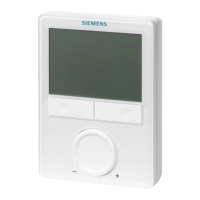38 / 66
Siemens RDG100, RDG100T, RDG110, RDG140, RDG160 Basic Documentation CE1P3181en
Building Technologies Functions 14 Dec 2011
This function is available with RDG100, RDG100T and RDG100T/H only.
Heating: Output Y1 provides the OPEN command, and Y2 the CLOSE command
to the 3-position actuator. Cooling: Idem with Y3 and Y4.
The factory setting for the actuator's running time is 150 seconds. It can be
adjusted via parameters P44 (Y1 and Y2) or P45 (Y3 and Y4).
The parameters are only visible if 3-position is selected via DIP switches 4 and 5.
1. When the thermostat is powered up, a closing command for the actuator
running time + 150% is provided to ensure that the actuator fully closes and
synchronizes to the control algorithm.
2. When the thermostat calculates the positions "fully close" or "fully open", the
actuator's running time is extended + 150% to ensure the right actuator
position is synchronized to the control algorithm.
3. After the actuator reaches the position calculated by the thermostat, a waiting
time of 30 seconds is applied to stabilize the outputs.
This function is available with RDG100, RDG100T and RDG100T/H only.
The demand calculated by PI control from the current room temperature and set-
point is provided via Y1 and Y3 to the valve actuator as a PWM signal (pulse width
modulation) for thermal actuators. The output is activated for a period proportional
to the heating / cooling demand and then switched off for the rest of the PWM
interval.
The interval is 150 seconds (factory setting). It can be adjusted via parameters
P44 (Y1) or P45 (Y3). These parameters are only visible if 2-position is selected via
DIP switches 4 and 5 and if PWM is selected via P46 and P47.
For PWM, the integral time (P35) must be set to 0.
For thermal valve actuators, set the running time to 240 seconds.
Never apply PWM to an electromotoric actuator
It is not possible to ensure exact parallel running of 2 or more thermal valve
actuator. If several fan coil units are driven by the same thermostat, preference
should be given to electromotoric actuators with on/off or 3-position position
control.
For electric heaters, set the running time to 90 seconds.
To avoid burn-off of mechanical contacts by frequent switching, use a current valve
in place of a relay or contactor.
For PWM, the integral time (P35) must be set to 0.
This function is available with RDG140 and RDG160 only.
The demand calculated by PI control from the current room temperature and
setpoint is provided via Y10 and Y20 to the valve actuator as a continuous
DC 0...10 V signal.
The demand calculated by PI control from the current room temperature and
setpoint is provided via Y20 as a continuous DC 0...10 V signal.
The signal converter (SEM61.4) converts the DC 0...10 V signal to AC 24 V
PDM pulses for the current valve.
The current valve (SEA45.1) supplies the electric heater with AC 50…660 V
pulsed current.
3-position
control signal
Synchronization
PWM control
Note!
PWM for thermal
valve actuators
Note!
PWM for electric heaters
Note!
DC 0...10 V control
DC 0...10 V
for valve actuators
DC 0...10 V
for electric heaters

